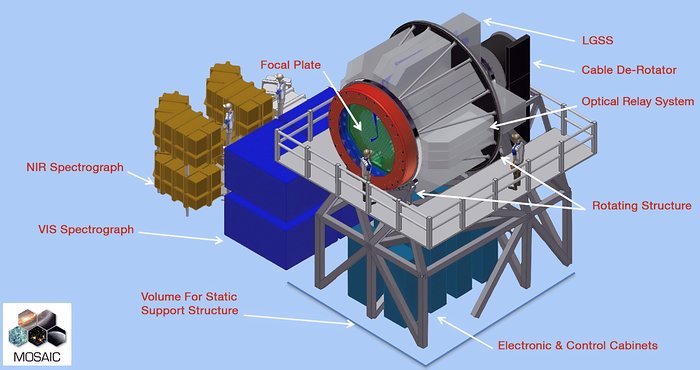MOSAIC is a multi-object and multi-integral spectrograph proposed for the ESO Extremely Large Telescope (E-ELT), i.e. the future largest optical/near-infrared telescope in the world. MOSAIC is currently in the initial project stage (Phase A).
The MOSAIC consortium includes institutions from five countries (France, United Kingdom, The Netherlands, Brazil and Germany) with six associated partners (Austria, Finland, Italy, Portugal, Spain and Sweden). The international MOSAIC consortium, with its long and recognized experience in instrument development and conception for ESO (e.g. FORS, KMOS, MUSE, SPHERE, NACO, VIMOS, XSHOOTER), gathers together efforts across Europe and Brazil to build this unique ELT survey machine.
MOSAIC will be a multi-purpose instrument that will be able to tackle many different scientific cases combining the high-multiplexing with an unprecedented spatial resolution.
The instrument design foresees two main different operating modes: a high multiplex mode (HMM) covering the visible and near-infrared domain, and a high definition mode (HDM) that will provide spatially resolved observations in the near-infrared.

The HMM allows to observe simultaneously 200 astronomical objects in the visible domain (450-800 nm proposed, 370-800 nm desired), or 100 in near infrared (800-1800 nm proposed, 800-2500 nm desired) within the 32 arcmin2 of E-ELT field of view, with a spectral resolution R = 5000-15000.
The HDM with its 10 integral field units, allows to obtain spatially resolved observations at high definition for 10 astronomical objects in the ELT field of view. The HDM operates with the multi object adaptive optics (MOAO) in the near-IR (800-1800nm) reaching R = 5000.
Coupled with the impressive E-ELT capabilities, MOSAIC will be able to obtain visible and near-infrared spectra for huge samples of astronomical objects, from Milky Way stars up to the farthest galaxies at the epoch of re-ionization. It will able to detect the earliest “first-light” structures in the Universe, to conduct the most exhaustive dynamical survey of distant galaxies ever undertaken, and to undertake the first detailed study of stars in galaxies millions of light years beyond the Milky Way. These unprecedented observations will map the galaxies evolution and the matter distribution along the whole history of the Universe from epochs near the Big Bang to the present day.
MOSAIC will give a tremendous leap forward in our understanding of how present-day galaxies formed and evolved. In the words of François Hammer, Principal Investigator for MOSAIC: “MOSAIC will be the only ELT instrument able to obtain the sample sizes needed for significant progress in cosmology, extragalactic and galactic science, delivering spectra of a significant number of targets among the thousands included in one exposure with the ELT. In particular, MOSAIC will provide a world-leading and unique capability for spectroscopic follow-up of the most distant galaxies in the Universe, exploiting the legacy of future space missions” (source ESO website)
IASF-Milano is involved within the Italian team participating to the project, providing expertise on scientific performance evaluation techniques already used for other instruments like VIMOS or Euclid/NISP.
For more information consult the official MOSAIC website
